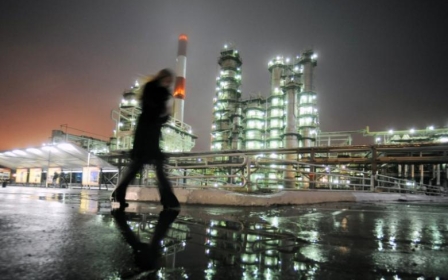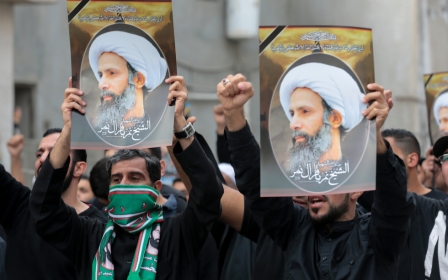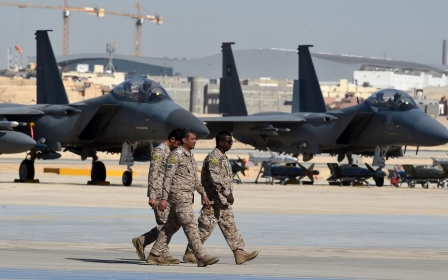Saudi soldier killed in clashes as siege of Shia town enters seventh day

A soldier was reported killed by gunmen in the Saudi town of Awamiyah where a "siege" by security forces entered its seventh day, according to the interior ministry. Five members of the security services were also injured.
Several people have been reportedly killed in the town after Saudi security services launched a raid in the Eastern Province town early on Wednesday, claiming the historic Almosara neighbourhood was being used as a hideout for Shia militant groups.
Gunmen have repeatedly opened fired on police and roadblocks have been placed at entrances to the town, restricting access.
The Eastern Province has a large Shia population who have frequently been accused of being linked to Iran and carrying out anti-state activity. Awamiyah, in particular, has been a flashpoint - in March, a teenager was killed by Saudi police after they "responded as necessary" to gunfire from militant groups.
Another aim of the raid, however, appears to be to enable the demolition of Almosara to make way for a planned renovation project. Activists have posted pictures and videos of bulldozers being accompanied by heavily armoured military vehicles towards the site.
One Awamiyah local, speaking to MEE on condition of anonymity, said that residents were working together under a state of "siege" to try and keep local amenities running.
"But regarding electricity still there is lots of houses outside Almosara without electricity, living on generators," they said. "As a result of the destruction of public and private property that was imposed by Saudi forces, many generators were damaged."
Video sent to MEE appeared to show concrete blocks placed on roads leading out of the town, though this footage cannot be independently verified:
"Since the final exams started on Sunday, in specific periods people can go out especially in the morning during school time from a specific road, with fears of being harassed, arrested or being shot carelessly and killed as reported," the resident said.
"Even while answering your question, everybody in my town can hear the sounds of shooting by armoured vehicles."
Boy, aged two, among several killed
According to a statement from the interior ministry on Friday, workers on the project in Almosara "came under fire and their vehicles were targeted by explosives" from within the neighbourhood. A two-year-old Saudi boy - identified by the pro-government Al-Arabiya news site as Jawad al-Dagher - and a Pakistani resident were killed in the shooting.
The ministry did not specify when the attack took place but said criminals engaged in the drugs and arms trade had tried "to jeopardise the project and protect their terrorist activities that they launch from the abandoned houses in the neighbourhood".
Al-Hayat newspaper also reported that a man wanted by the authorities had been shot dead, while the Mira al-Jazeera news site claimed two locals had also been killed by the security services in the ensuing clashes.
"A citizen was confirmed martyred as well as another of Indian nationality after being shot by Saudi army gunfire," the online newspaper reported on its Facebook page. The European Saudi Human Rights Organisation (ESHRO) identified one of the men as Ali Abdul Aziz Abu Abdullah.Dozens have reportedly been injured. The interior ministry said 14 people were wounded, including two Pakistanis, an Indian, a Sudanese and four policemen.
"The situation's miserable," a resident told AFP, asking for anonymity. "We think it will take a long time to finish this operation."
'It's really hard for people and you can imagine these army vehicles, they would open fire like 24 hours. People can't sleep'
- Ameen Nemer, activist
Residents have also reported a lack of water and mains electricity, with only private generators providing power.
People from the Almosara neighbourhood have been asked to leave by authorities, while photos circulating on social media have shown special police wearing balaclavas and camouflage pants moving residents in armoured cars.
Ameen Nemer, an activist originally from Awamiyah, told MEE that "most of the entrances to Awamiyah" had now been blocked off and that there was only one entrance still in use, which was also frequently closed.
Project puts pressure on residents
The planned "renovation" of the historic 400-year old Almosara district has been highly controversial. In April, the United Nations called on the Saudi government to halt the project, warning that it threatened "the historical and cultural heritage of the town with irreparable harm".
“Residents have been pressured in many ways, including through power cuts, to vacate their homes and businesses without adequate alternative resettlement options, leaving them at best with insufficient compensation and at worst, with nowhere to go," said the UN Special rapporteur on the right to adequate housing, Leilani Farha.
The Awamiyah resident said he was deeply worried about the threat to Almosara.
"The government doesn't want to improve the city. They mainly want to killed some men hiding inside Almosara."
Awamiyah was also the home of Nimr al-Nimr, a Shia cleric executed in January last year for "terrorism," leading to massive protests internationally, including the sacking of the Saudi embassy in Iran.
Nimr was a driving force behind protests by Shia that began in 2011 and developed into a call for equality in the Sunni-majority kingdom.
Since then, scores of activists have been arrested or killed, sometimes due to torture and execution.
Nemer said the spiralling violence in the town stemmed from the government's harsh response to calls for reform.
"I believe the government has, from the beginning in 2011, dealt with the [protesters'] demands in a military way, in a police way, that's why the thing has turned into chaos," he said.
Middle East Eye propose une couverture et une analyse indépendantes et incomparables du Moyen-Orient, de l’Afrique du Nord et d’autres régions du monde. Pour en savoir plus sur la reprise de ce contenu et les frais qui s’appliquent, veuillez remplir ce formulaire [en anglais]. Pour en savoir plus sur MEE, cliquez ici [en anglais].





